Here you will find a detailed overview of old and new types of lettuce and we will introduce you to the most important types of salad, from lettuce to chicory, with pictures.

The world of Salads (Lactuca sativa) is diverse and colorful. You don't have to choose a type or variety of lettuce, you can grow a wide variety of salads in your own garden. This means that fresh lettuce can be harvested almost all year round.
contents
- What types and types of lettuce are there?
-
Types and varieties of lettuce from the lettuce group
- Batavia salad
- Oak leaf salad
- Iceberg lettuce
- Lettuce
- Pick lettuce & cut lettuce
- Lollo salad
- Romaine lettuce
-
Types and varieties of lettuce from the chicory group
- Chicory
- Radicchio
- endive salad
- Sugar loaf salad
-
Types of lettuce without a group
- Lamb's lettuce
- Purslane
- Postelein
- arugula
What types and types of lettuce are there?
Botanically, most of the known salads can be divided into two groups: The lettuce group (
Lactuca) and the chicory group (Cichorium). Typical of the lettuce group is the milky, white sap that emerges from interfaces and is slightly bitter. The group includes, among others Lettuce, Iceberg lettuce, Batavia salad, Romaine lettuce, Picked and cut lettuce - count to this Oak leaf salad as well as Lollo Rosso resp. Bionda. The second group includes the chicories such as Chicory, Endive, Radicchio, Leaf chicory and sugar loaf. Salads in this group are much more bitter than lettuce. On the other hand, they also boast a higher vitamin and mineral content.Overview of the types of lettuce by group:
- Lettuce group: Lettuce, iceberg lettuce, batavia lettuce, romaine lettuce, pick and cut lettuce (such as lollo lettuce or oak leaf lettuce)
- Chicory Group: Chicory, endive, radicchio, sugar loaf, leaf chicory
- Other salads without a group: Lamb's lettuce, rocket, purslane, Postelein
Types and varieties of lettuce from the lettuce group
Crunchy, mostly green and healthy: the salads from the lettuce group are the ultimate salad classics. In the following we will introduce you to the individual types of the lettuce group and show you a selection of recommended varieties.
Batavia salad
Batavia Salad (Lactuca sativa var. capitata) is not even known to many, as this type of salad has only recently become more popular with us. The salad from France is similar in appearance to lettuce or iceberg lettuce. The special feature of this species are the leaves that are strongly curled on the edge of the leaf. These are mostly green, but depending on the variety, they can also be reddish or green with a red border.
Green batavia lettuce varieties:
- Agribelˈ: Loose heads with strongly curled leaves
- ˈDoree de printempsˈ: This variety has green leaves that are curled and blistered on the outside
- ˈImpressionˈ: This variety has an open, spherical habit and slightly wavy, light green leaves
- ˈKendoˈ: particularly crisp leaves
- ˈLenyˈ: Particularly large and light green heads of lettuce
- ˈSolasiaˈ: Lush, light green as well as strongly wavy and blistered leaves
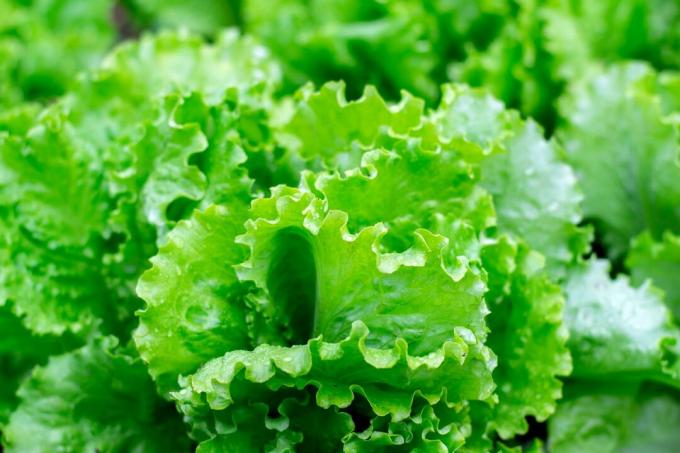
Red and colorful batavia lettuce varieties:
- ˈAmerican brown ’: This variety has delicately wavy leaves on the outside and red-brown and green on the inside
- ˈKamaliaˈ: Has very curled, reddish leaves
- ˈMaravilla de Veranoˈ: This variety is red with a delicate, light green heart
- ˈSaragossaˈ: Bears green leaves that become slightly reddish towards the leaf edges and does not form firm heads
- ˈSteirer Krauthäuptelˈ: This variety is also known as Grazer Salat and forms loose heads with green leaves with a red border
- ˈTarengoˈ: has red-green leaves that are slightly blistered
- ˈTeideˈ: Is particularly suitable as a sliced or plucked salad
Oak leaf salad
Of the Oak leaf salad (Lactuca sativa var. crispa) is sometimes also called oak lettuce or American lettuce because its partially loose heads are ideal as a cut or lettuce salad. So it is a variation of the pick salad. Other varieties, on the other hand, also have firmer heads that can be harvested as a whole. The typical leaves of the oak leaf lettuce with their wavy edges are strongly reminiscent of oak leaves.
Oak leaf lettuce varieties with green foliage:
- ˈPiroˈ: Produces particularly large heads with firm, green leaves
- ˈRadichettaˈ: Serrated, pointed, green leaves make the heads of this variety look very special
- ˈSalad Bowlˈ: Forms particularly large heads with lush green leaves
- ˈSmileˈ: Forms large, open, filled heads in light green
- ˈStrubelpeterˈ: Forms large, dense rosettes of leaves; the leaves are light green
- ˈTillˈ: The leaves of this variety are green with a light yellow heart; their shape is also special: the leaves are pointed

Oak leaf lettuce varieties with red foliage:
- ˈBijellaˈ: Medium-sized, compact heads with red-brown colored leaves with a fresh, green heart
- ˈBolchoïˈ: Forms red, wavy leaves; the heads are compact and open
- ˈNavaraˈ: The leaves of this variety are both green and red
- ˈRed Salad Bowlˈ: This light red variety of oak leaf lettuce forms large, relatively loose heads
- ˈRubinetteˈ: This variety has open but double heads with crisp, red leaves
Iceberg lettuce
Iceberg lettuce (Lactuca sativa var. crispum) or ice cream salad is the classic among green salads. It originally comes from the USA and owes its name to the mountains of ice on which it was stored and kept fresh in the past. Growing in your own bed is very easy and the wide variety of different varieties invites you to try them out.
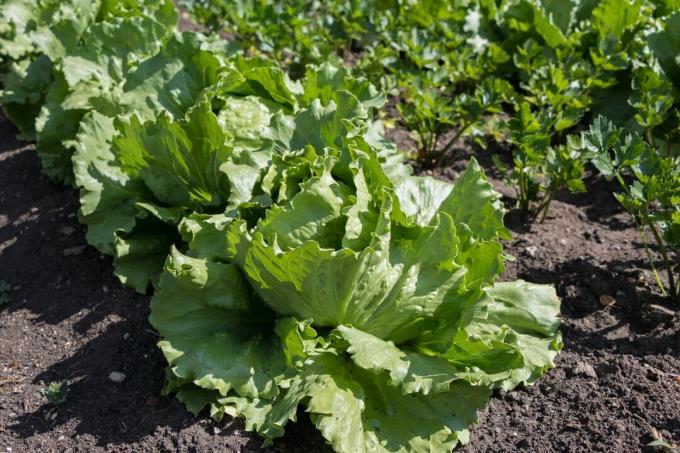
Recommended types of iceberg lettuce:
- ˈBarcelonaˈ: Forms large, round heads
- ˈBlondes de Parisˈ: Has yellow-green leaves that are particularly delicate
- ˈFortunasˈ: Forms large, bulletproof heads
- "Great Lakes 118": Firm, medium-sized heads with green, crisp leaves
- ˈLaibacher Eisˈ: Medium-sized, red-green painted heads
- ˈMariusˈ: Big, heavy heads; the leaves are light green
- "Myth": The outer leaves are jagged on the outside and lush green
- ˈRegina dei Ghiacciˈ: Large, densely filled heads made of intensely green, crispy serrated leaves
- ˈRossiaˈ: Well-filled, elongated heads with red-brown outer and yellow-green inner leaves
- ˈSaladinˈ: Particularly bulletproof and forms large, very tightly closed heads with yellow-green leaves
- ˈSiouxˈ: Delivers medium-sized heads with a bright dark red wrapper and binder
- ˈSophieˈ: This new breed forms firm heads with a red binder
- ˈStylistˈ: Iceberg lettuce variety that is resistant to lap; delivers a high yield
Lettuce
Of the Lettuce (Lactuca sativa var. capitata) is probably one of the best-known types of lettuce. Its large, rounded shape reminds us of a head, hence its name. Lettuce has tender, large leaves that are not crunchy. The buttery consistency of the leaves has earned it the second name butter lettuce. The leaves of the lettuce are mostly green, but there are also varieties with red or two-tone foliage.
Green lettuce varieties:
- ˈBriweriˈ: Compact, rather smaller heads with a strong binder and a lighter inner leaf
- ˈKagraner Summer 2ˈ: Suitable for cultivation in midsummer and forms fresh green, heavy heads
- ˈLarissaˈ: Very early, medium-sized, firm-headed variety
- ˈLucindeˈ: Fast development and moderately heavy heads; suitable for outdoor cultivation
- ˈLunaˈ: Green spring and summer salads with big heads
- ˈMaikönigˈ: Particularly spicy taste and medium-sized, firm heads
- ˈNeckarriesenˈ: Well suited for spring, early summer and autumn cultivation and forms particularly large, firm heads
- ˈRolandoˈ: Medium early, shiny, fresh green salad; the heads are big and heavy
- ˈSkipperˈ: Forms big, beautiful, light green heads
- ˈSuzanˈ: Robust and bulletproof
- "Miracle of Stuttgart": traditionally grown in summer; forms particularly tender, large, yellow-green heads
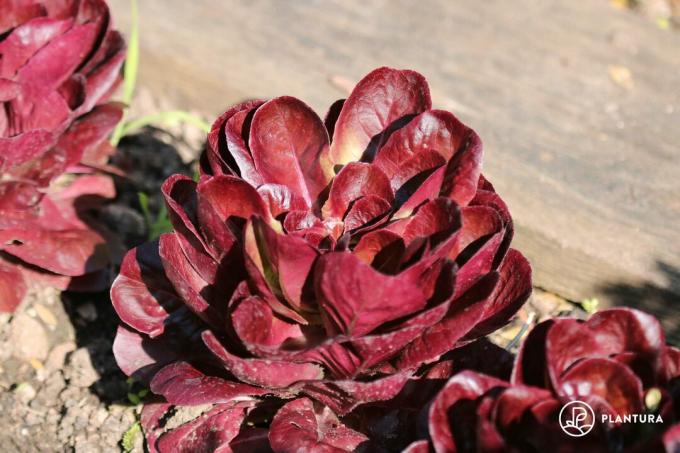
Red and colorful lettuce varieties:
- ˈColorful troutˈ: Colorful lettuce variety that surprises with its green leaves with dusky pink speckles; the heads are darker, stronger and larger than those of the gold troutˈ variety
- ˈGold troutˈ: The leaf color of this brightly colored lettuce variety is very special: the leaf is golden-green with dusky pink speckles and lighter towards the center
- ˈIndianerperleˈ: Brings out beautiful, medium-sized heads that are light yellow on the inside and strongly reddish on the outside
- ˈMerveille des quatre saisonsˈ: Red-brown colored lettuce variety with good head formation and good lap resistance
- ˈPiratˈ: Very fast growing, compact lettuce variety with red-brown leaves; forms a fine, slightly blistered leaf
- ˈRoxy redˈ: Red lettuce variety that develops dark red, shiny outdoor lettuce with a light green lettuce heart
Pick lettuce & cut lettuce
Sliced and Picked Salad (Lactuca sativa var. crispaIn contrast to, for example, lettuce, lettuce does not form firm heads, only loose leaf rosettes. The advantage here is that individual lettuce leaves can be harvested as required and the lettuce grows back again and again. So you can enjoy fresh salad all summer long.
Picking or Salad is very diverse and mostly varieties of oak leaf lettuce, batavia lettuce or Lollo Rosso or Bionda used. In general, all sorts of the types listed can be used as pick and cut lettuce, which grow loosely and do not form firm heads. Mixtures are often offered in stores that are particularly suitable for growing as a pick salad.
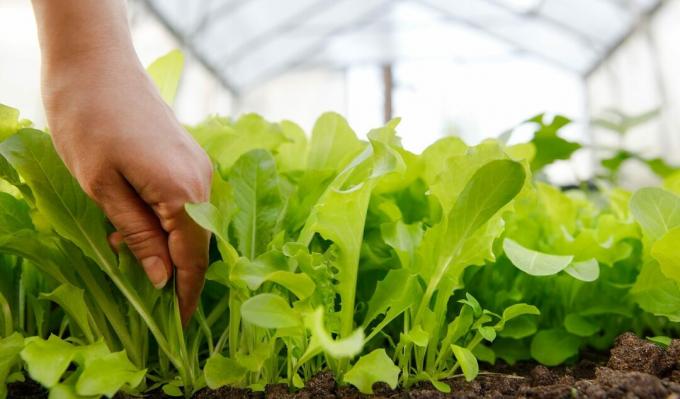
Recommended types of lettuce and lettuce:
- "Australian yellow": Forms large, leafy individual plants with light green, delicate leaves
- ˈCatalongaˈ: fast growing variety; forms dense bushes with long, lobed, dandelion-like, delicate, crisp, light green leaves
- ˈGritˈ: Newly bred variety with dark red leaves; can be grown from spring to autumn
- "Ox tongue": Forms large plants with strong green, fleshy, tender leaves with a slightly nutty taste
- ˈRed Velvetˈ: Particularly dark, red-brown foliage; has a mild, full taste
- ˈRedboneˈ: Shiny red and slightly blistered leaves; can be grown from spring to autumn
- "Swabian Yellow": Old Swabian local variety with yellow-green, firm leaves
- ˈSolmarˈ: Very curled and bright red leaves
- ˈWitte Dunselˈ: Makes smooth, light green leaves and can be grown year round
Lollo salad
Lollo salad (Lactuca sativa var. crispa) can be used as a whole head of lettuce or as a picking or Salad can be grown and is therefore also a variation of the pick lettuce. It is characterized by its particularly curly leaves. There are two types of lollo salad, namely a red and a green.
Red and green lollo lettuce varieties:
- ‘Lollo Rosso’: Delivers small, very curly plants with dark red foliage; the harvest time is from mid-May to mid-September
- ‘Lollo Bionda’: The green brother of ‘Lollo Rosso’ is just as curly, but has light green leaves

Romaine lettuce
The romaine lettuce (Lactuca sativa var. longifolia) is also known under the names romaine lettuce, endive, summer or cooked salad. It is a summer salad and can be enjoyed both raw and cooked. It forms long, firm heads of lettuce with green outer leaves and a yellow lettuce heart. The leaves are particularly crisp and can be stored for longer than other salads. Some varieties also develop red leaves. The taste is spicy and slightly bitter. Compared to other salads, romaine lettuce contains a lot of vitamins C and A as well as iron.

Recommended types of romaine lettuce:
- ‘Attico’: Develops dark green, approx. 12 cm high romaine salads and is known for the excellent taste and the lettuce hearts
- ‘Corbana’: Particularly large and upright growing heads
- ‘Gohar’: Mini romaine lettuce with green leaves
- ‘Intred’: Mini romaine lettuce with red leaves
- ‘Lentissima a Montare Sel. Franchi ’: Particularly long heads and delicately ribbed, light green heads
- ‘Little Gem’: Compact, small, fast-growing romaine lettuce with a heavy weight
- ‘Moonred’: Deep dark red leaves
- ‘Tantan’: crisp, approx. 18 cm high romaine lettuce with very tasty lettuce hearts
- "Devil's Ears": specialty from France; has elongated green leaves with dark red tips
- ‘Valmaine’: Classic, upright, dark green romaine lettuce variety; forms crisp, elongated leaves and can also be grown well as a baby leaf salad
- ‘Xanadu’: Forms compact growing mini romaine lettuce with a short stem
Types and varieties of lettuce from the chicory group
The salads that belong to the chicory group all have one thing in common: they have a bitter taste. On the other hand, they are also particularly healthy thanks to their vitamins, minerals and bitter substances.
Chicory
Chicory (Cichorium intybus var. foliosum) does not look like a typical salad at first glance, as its shape is more reminiscent of a pointed head of cabbage. In fact, the winter salad can be enjoyed both cold and warm. Chicory is particularly popular in France and the Benelux countries, which is why it is also known as the Brussels salad. Cultivation in our latitudes is not that easy, but it can also be successful if the right variety is chosen.
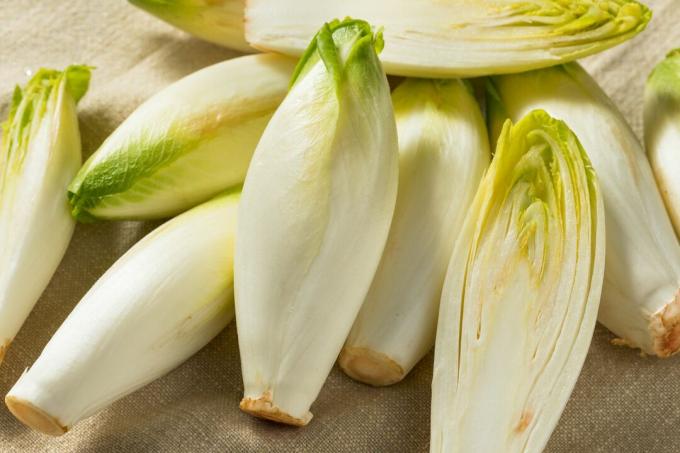
Recommended types of chicory:
- ˈBrussels Witloofˈ: Forms yellow-green, firm heads
- ˈDi Bruxellesˈ: Forms heavy, strong heads; Harvest time is from the beginning of December to the end of February
- ˈEtardoˈ: Forms firm, small heads and can be harvested between December and March
- ˈMacunˈ: New variety with a high yield, which is ready for harvest from mid-November to the end of January
- ˈRobinˈ: Forms white heads that are rimmed with purple instead of the typical yellow
- ˈZoomˈ: Fixed long heads; Harvest time between October and November
Radicchio
Radicchio (Cichorium intybus var.foliosum) is known as a round or elongated, red-leaf salad with a bitter note. The salad comes from Italy and, thanks to its bitter substances, is beneficial for the stomach and digestion and can also be used in many ways in the kitchen. The varieties are classified according to their shape and color: there are round, oblong and colorful radicchio.

Round radicchio varieties:
- ‘Orchidea Rossa’: completely bright red leaves; The head is loosely open
- ‘Palla Rossa’: Forms round, small heads that shine in an appetizing red with white veins
- ‘Rosso di Chioggia’: Forms the round, dark red heads with white ribbed leaves that are typical of radicchio; is also well suited for cultivation in northern Germany
Elongated radicchio varieties:
- ‘Di Trevisio’: Particularly high-growing varieties; good resistance to cold; has white ribbed, dark red leaves
- ‘Granato’: Elongated head shape and deep red leaves with white veins; is ideal for dipping sauces, creams and for topping and decorating bread
- ‘Treviso 206 TT’: Forms compact, elongated heads with deep red leaves with wide, white petioles

Colorful radicchio varieties:
- ‘The yellow one from Trieste’: Impresses with its yellow-green, round oval leaves that have a mild taste
- ‘Galileo’: yellow to light green radicchio; special pink-red spots; fine, mild taste; highly recommended for salads
- ‘Variegata di Lusia’: Fixed heads in light green; fine and mild taste
endive salad
the endive (Cichorium intybus) is a late summer salad with a high vitamin and mineral content. The taste, however, does not suit everyone, because it is quite bitter. Endives are frugal in cultivation and they can grow well here too, although they originally come from the Mediterranean region.

Recommended endive lettuce varieties:
- ˈBionda a cuore pienoˈ: Forms large, green-leaved heads that are not very curly
- ˈBubikopf 2ˈ: Robust variety with slightly wavy leaves and a dense, self-bleaching heart
- ˈCuor d‘Oroˈ: Forms big heads with filled hearts
- ˈDivaˈ: Impresses with its upright growth and the lettuce heart, which is very full from an early age
- ˈEminenceˈ: Very fast and productive variety with densely filled heads and a high percentage of yellow in the heart
- ˈErosˈ: Particularly large, slightly curled leaves
- ˈGroboˈ: has broad, green, short and upright leaves and is also hardy and productive
- ˈLarge Pancalièreˈ: old variety; is valued for its particularly pronounced leaf curl
- "Green Escariol": Reliable and sensitive to frost; the leaves are green, the lettuce hearts yellow
- ˈMyrnaˈ: very productive variety; impresses with a tightly filled, light yellow lettuce heart
- ˈNuanceˈ: Very robust, smooth-leaved, fast-growing endive lettuce variety with a densely filled, aromatic heart
- ˈPancalieriˈ: elongated and wavy leaves of an intense green color with long white ribs; white and voluminous heart
- ˈWalloneˈ: Particularly curled, green-leaved; nicely filled center
Sugar loaf salad
Of the Sugar Loaf (Cichorium intybus var. foliosumAs a chicory salad, it is closely related to endive and radicchio. It also tastes bitter and is grown in autumn. It owes its name to the typical sugar loaf shape. Its bitter substances and minerals make it valuable for nutrition and it is easy to grow in the garden. Another advantage of the Sugar Loaf is that it can be stored easily, which is rather untypical for salads. The variety selection for the Sugar Loaf is not very extensive.
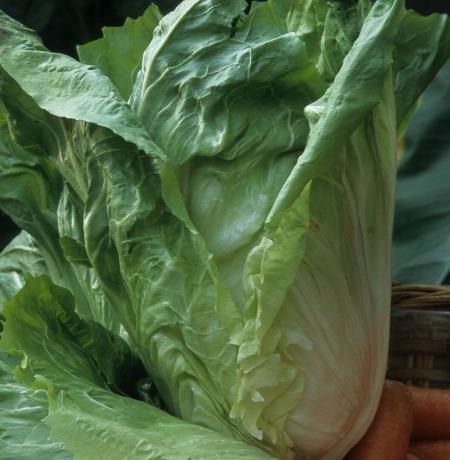
Recommended types of sugar loaf salad:
- ‘Nettundo TT’: Forms compact, cylindrical heads with a very aromatic, slightly sweet taste
- ‘Auslese’: Highly round, mostly pointed heads
- ‘Uranus’: wears long, high-necked heads
Types of lettuce without a group
Some salads are neither chicory nor lettuce. We will introduce you to these types of lettuce below.
Lamb's lettuce
Lamb's lettuce (Valerianella locusta) is known by many melodious names: it is also called Rapunzel, Nüssli or Vogerlsalat. As a winter salad, it can still be harvested when most other salads have paused. In addition to its nutty taste, it is also valued for its high vitamin content. The varieties are roughly divided into two groups: large-leaved and small-leaved varieties, with the small leaves have a more aromatic taste, while large-leaved varieties have a yield is higher.
Lamb's lettuce varieties with small leaves:
- ˈFavorˈ: Dark green, fast growing leaves; suitable for year-round cultivation
- ˈGalaˈ: Robust and fast growing and suitable for year-round cultivation
- ˈKölner Palmˈ: old variety from Cologne; has elongated, light green leaves and a distinctive aroma
- ˈMirtaˈ: Very productive and fast growing
- ˈVerte à coeur plein 2ˈ: robust, small-leaved variety; is also called dark green full hearted
- ˈVerte de Cambraiˈ: Small, round leaves in a dark green color

Lamb's lettuce varieties with large leaves:
- ˈAmelyˈ: suitable for growing in autumn, winter and spring; dark green, leaved variety
- ˈElanˈ: Compact and very fast growing; very productive
- ˈEtampesˈ: Dark green leaves and a rich harvest
- "Dutch broad-leaved tiger": Elongated, rather light green leaves
- ˈLisbeth's Rapünzelchenˈ: old, robust variety; elongated leaves in a delicate green
- ˈVitˈ: compact growing varieties; clear veins on the round, dark green leaves
Even more interesting Lamb's lettuce varieties You will find here.
Purslane
Purslane (Portulaca oleracea) is not a classic salad, but its small, round, dark green leaves provide crunchy leafy vegetables throughout the summer that can be enjoyed like salad. Summer purslane is also extremely healthy: the leaves are full of vitamins and minerals. In addition to wild purslane, there are also cultivated varieties.

Recommended purslane varieties:
- ˈFireflyˈ: can grow up to 50 cm high and produces a very rich harvest; the leaves have a rather sour taste
- ˈKuzminsky Semkoˈ: Develops light green leaves and small, yellow flowers; fast growing variety; quickly produces a lot of leaf mass
- ˈMacoveiˈ: vigorous variety; crisp, green leaves
- "Paradox": particularly thick, fleshy leaves; ripe very quickly
Postelein
Not to be confused with the purslane, but confusingly similar Postelein (Claytonia perfoliata). In contrast to the summer purslane, Postelein is grown over the winter. Other well-known names for Postelein are common plate herb, cubaspinach or winter purslane. Originally native to North America, the herb grows very well here too and provides many vitamins and minerals during the cold season. However, the leafy vegetables don't look like a typical salad: Postelein consists of long stems with egg-shaped, fleshy leaves. These are characterized by their fresh, sour, yet mild taste.

arugula
Behind the Italian name arugula hides two different types of plants: one is the common rocket (Eruca sativa) and next to it the wild rocket (Diplotaxis tenuifolia). Both types contain a lot of mustard oils; therefore they have their intense, tangy, slightly pungent taste, which is why many people particularly appreciate arugula. Although both rocket species are similar in cultivation, there are still some small but subtle differences. The leaves of the wild rocket are smaller and more narrowly pinnate than those of the common rocket. The wild rocket can be cultivated for several years and has a more intense taste. The rocket is only cultivated as an annual and has a milder taste. It is also faster growing.

Varieties of wild rocket:
- ˈDragons Tongueˈ: sturdy variety; has an intense, spicy aroma
- ˈNapoliˈ: high yield; particularly broad leaves
- ˈVeniciaˈ: Due to its late flowering time, this variety can be grown for a particularly long time
Varieties of rocket salad:
- ˈColtivataˈ: Broad, fast growing leaves
- ˈProntoˈ: Very fast growth and good taste
- ˈWildfireˈ: Broad, light green leaves; particularly sharp taste
- ‘Sylvetta’: Fast growing variety with fine leaves and an early flowering point; nice, slightly nutty aroma
More about the different ones Varieties of arugula can be read here.
tip: For a rich harvest, it is best to use a high quality and nutrient-rich substrate like ours Plantura organic tomato & vegetable soil.
